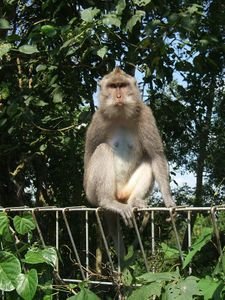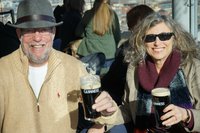Advertisement
Published: December 6th 2007

 Monkey
Monkey
Enjoying the Monkey Forest SanctuaryUbud, Bali
After 5 great days in Lovina Beach, we traveled a little over 2 hours to reach the town of Ubud. The drive takes 2 hours, but the actual distance is only about 40 or 50 km. The roads wind through the volcanic hills of Bali and through many villages along the way.
Bali is a very green island thanks to the rich soil and abundance of precipitation. We are here during the rainy season, but it has been unusually dry according to the residents. The land still appears quite green and lush, despite the fact that the rains have not started yet. During our stay, we did witness the start of some prodigious rainstorms, which are about 6 weeks late. They usually happen in the afternoon.
Ubud is the cultural center of Bali and contains many shops owned by local artisans who sell their work. The shops sell everything from clothing to paintings to jewelry to wood carvings. We found the town itself fairly quiet as we are here before the start of the holiday travel season for Europeans and Australians.
We stayed at the Alam Shanti, which is part of a group of accommodations.
The place is best described as an open air Balinese bungalow. Each thatched roof building has two suites, each having very large open aired porches. A gentle breeze blows most of the time. The windows however need to be closed up at night because the bugs come calling. The beds are of the 4-poster variety and have mosquito netting. Each night around sunset, the staff brings mosquito coils in pots that are placed on the porches to stave off the bugs. The accommodations were quite nice and very peaceful. At night we fall asleep to the sounds of croaking frogs and awake to a cacophony of sounds; cicadas, several different kinds of birds and don’t forget the roosters.
Ubud has monkeys. In fact, a short walk from our bungalow is the Monkey Forest Sanctuary where over 300 monkeys make their home. We visited them and observed that they know when someone has food that is purchased for them. We watched as one tourist held up a banana and the next thing you know, a 15 pound monkey climbed right up on her and retrieved the banana. The monkeys can be amusing to watch, but we were forewarned to keep
a close eye on our backpack as they are well-known kleptomaniacs. Another time, one of the monkeys snarled at Merry Jo after she spent some time trying to take her picture. Apparently she had enough of MJ’s camera at that point.
We took a Balinese cooking class and learned how to make traditional foods like chicken satay and salads. One night we dined at a Balinese restaurant and took in a traditional dance performance. It was a dance by many locals which depicted tales of folklore in the region, with many of the dancers chanting. It was very colorful and including the use of fire in its depiction.
Another afternoon, we drove out to see the rice terraces and the herons. The rice terraces are spectacular to behold and a marvel of agricultural work without machinery. Like many things viewed outdoors, you can stand and look at the terraces for quite a while and continue to be amazed at the work of man.
We also drove a short distance away to view the herons, which arrive each afternoon to nest among the trees in a small village. There are hundreds of these magnificent birds to look at
which live among the villagers. You have to be careful so that a big white present isn’t delivered on top of your head!
Ubud can best be described as a quiet slice of Balinese cultural life. The people are incredibly friendly and take great pride in making sure that guests enjoy their stay and are treated well. We enjoyed the laid back lifestyle of this slice of paradise.
Once again we were glad to have a calculator with us as the Indonesian currency is the rupiah, and it takes over 9200 of them to equal the U.S. dollar. We don’t even blink anymore when we pay 15,000 for a beer.
More facts about Indonesia and Bali:
If you were to add up the coastline of the 13,000 islands in Indonesia, it would amount to 33,755 miles (54,716 km). There are 667 airports, and as of 2003, there were 2000 illegal radio and TV stations.
Crude oil and natural gas are Indonesia's most valuable natural resources and have long been its major source of export revenue, but declines in production since the 1990s made the nation a net importer of oil in 2004. Agriculture accounts for
about 16% of the GDP and employs over 40% of the labor force. Indonesia is one of the world's major rubber producers; other plantation crops include sugarcane, coffee, tea, tobacco, palm oil, cinchona, cloves, cocoa, sisal, coconuts, and spices. Despite plantation cultivation, Indonesia has a wide landholding base; the majority of the people are largely self-sufficient in food. Rice is the major crop; cassava, corn, yams, soybeans, peanuts, and fruit are also grown.
Next we move to Sanur, a resort area in Bali for our final stop in Asia.
Advertisement
Tot: 0.049s; Tpl: 0.013s; cc: 11; qc: 25; dbt: 0.0266s; 1; m:domysql w:travelblog (10.17.0.13); sld: 1;
; mem: 1.1mb




























